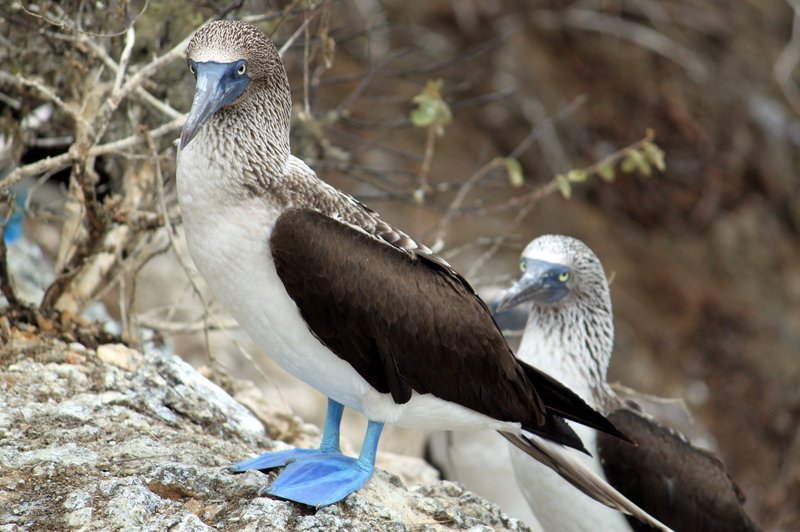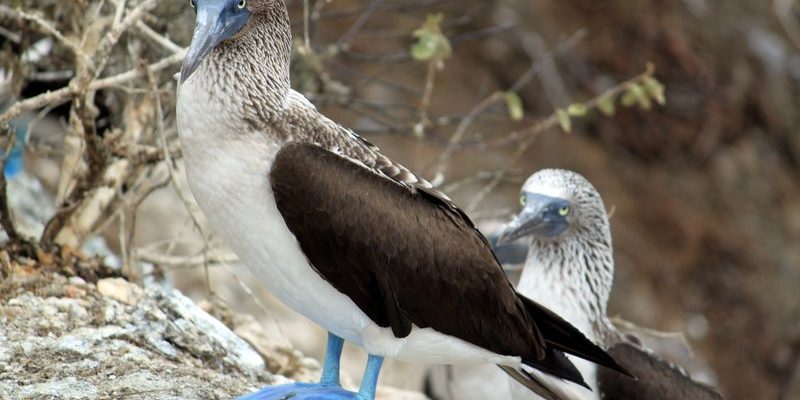
The Blue-Footed Booby is one of nature’s most colorful characters. With its vibrant blue feet, this seabird stands out in a crowd, grabbing attention wherever it goes. Imagine a bird that literally has feet so bright they could be mistaken for a pair of flashy sneakers! But there’s much more to this fascinating creature than just its striking appearance.
Natively found in the tropical and subtropical regions of the Pacific Ocean, particularly around the Galápagos Islands, the Blue-Footed Booby thrives in some truly breathtaking environments. Here’s the thing: their unique blue feet aren’t just for show. They play a crucial role in courtship and mating rituals, showcasing how stunning aesthetics can serve a significant purpose in the animal kingdom. Let’s dive into the world of the Blue-Footed Booby and explore what makes this bird so special.
Physical Characteristics
The first thing you’ll likely notice about the Blue-Footed Booby is, of course, its bright blue feet. These feet aren’t just for decoration; they’re a vital part of their mating dance. Male boobies boast even brighter hues, which signal their fitness to potential mates. Think of it as Mother Nature’s way of ensuring that only the healthiest and strongest genes are passed on!
In terms of size, Blue-Footed Boobies are medium-sized birds, measuring about 32 inches in length. With a wingspan of approximately 5.5 feet, their impressive aerial acrobatics are something to behold. Their bodies are mostly white with brown and gray markings that help them blend into their rocky coastal habitats. This clever coloring provides camouflage against predators while they nest on rocky cliffs or sandy beaches, making them a delightful mix of beauty and practicality.
| Size | 32 inches in length |
| Wingspan | 5.5 feet |
| Color | White body with brown and gray markings |
| Feet Color | Bright blue |
| Weight | 3-5 pounds |
Habitat and Distribution
You can typically find Blue-Footed Boobies along the coasts of the Pacific Ocean, particularly around the Galápagos Islands, the coast of Ecuador, and parts of California and Mexico. Their favorite spots are rocky shorelines where they can easily dive for fish, their primary food source. These areas provide ample opportunities for nesting and raising their young, which is essential for their survival.
Being marine birds, they are highly adapted to life on the coast. They prefer locations with abundant food supply, especially small fish such as sardines and anchovies. Because they dive from the air to catch their prey, their presence often indicates a rich marine ecosystem. This connection with their environment demonstrates how vital healthy oceanic habitats are not just for them, but for many other species as well.
Feeding Habits
The Blue-Footed Booby has an interesting way of feeding. They’re expert divers, plunging headfirst into the ocean to catch fish. They can dive from heights of up to 30 meters (about 100 feet) and can reach speeds of around 60 miles per hour while doing so. This impressive skill makes them one of the most efficient hunters in their habitat. Watching them dive is a spectacle—like a feathered rocket hitting the water.
They primarily hunt fish but also consume squid and other marine creatures. The way they fish is quite unique; they often dive in groups, which increases their chances of catching something. The birds will work together to herd fish into tighter groups, making them easier to catch. This teamwork shows just how intelligent these creatures are, adapting their methods for maximum efficiency.
Breeding and Nesting
The breeding season for Blue-Footed Boobies typically begins in late winter and can last until late summer. During courtship, males perform an elaborate ritual, showcasing their blue feet and dancing to attract females. They puff out their chest and spread their wings, strutting around like a model on a runway. This display isn’t just for show; it’s a way for females to gauge the health and vitality of potential mates.
Once paired, they usually build a simple nest on the ground, made from rocks and debris. These nests are often located on cliffs or rocky areas, providing a safe space for their eggs. A female Blue-Footed Booby typically lays one to three eggs, which both parents take turns incubating for about 40 days. After hatching, both parents are involved in feeding and caring for the chicks, showing remarkable parental dedication.
Conservation Status
Currently, the Blue-Footed Booby is listed as Least Concern on the IUCN Red List, meaning they are not at immediate threat of extinction. However, their populations can be affected by environmental changes, such as overfishing and climate change, which impact their food supply. Conservation efforts are essential to maintain healthy populations and protect their habitats, especially in areas where human activity encroaches on their living spaces.
The Galápagos Islands, where they are most commonly found, are a protected area, and several programs focus on conservation and education about these stunning birds. Preserving their natural habitat is crucial, not just for the Blue-Footed Booby but for the entire ecosystem that relies on a balanced marine environment. So, next time you hear about these quirky birds, remember that their survival is tied to the health of our oceans.
Behavior and Social Structure
Blue-Footed Boobies are social creatures, often seen in large colonies during breeding and feeding. Their social dynamics are fascinating to observe. They establish a pecking order, with dominant birds having better access to food and nesting sites. This hierarchy plays a significant role in their social interactions and feeding patterns.
Interestingly, these birds are also known for their distinct personalities. They can be quite curious and unafraid of humans, which makes them a favorite among birdwatchers and tourists in the Galápagos Islands. Their playful antics, combined with their striking appearance, make for unforgettable encounters. Observing them in their natural habitat gives us insight into their behaviors and how they interact with one another and their environment.
FAQs
What do Blue-Footed Boobies eat?
Blue-Footed Boobies primarily eat fish, including sardines and anchovies, but they may also consume squid and other marine creatures. They are skilled divers, plunging into the ocean at impressive speeds to catch their prey.
Where can I find Blue-Footed Boobies?
You can find Blue-Footed Boobies along the coasts of the Pacific Ocean, particularly in the Galápagos Islands, Ecuador, and parts of California and Mexico. These areas provide the rocky shorelines and abundant food sources that these seabirds need to thrive.
How do Blue-Footed Boobies attract mates?
Males attract females through a courtship display that involves showcasing their bright blue feet and performing dance-like movements. The brightness of their feet signals their health and vitality, which is crucial for attracting a mate.
How many eggs do Blue-Footed Boobies typically lay?
A female Blue-Footed Booby usually lays one to three eggs per breeding season. Both parents take turns incubating the eggs for about 40 days and share the responsibility of feeding and caring for the chicks once they hatch.
What is the conservation status of Blue-Footed Boobies?
Blue-Footed Boobies are currently listed as a species of Least Concern on the IUCN Red List. However, they face threats from environmental changes, overfishing, and climate change, making conservation efforts important to ensure their survival.
Are Blue-Footed Boobies social birds?
Yes, Blue-Footed Boobies are very social creatures. They often form large colonies during breeding and feeding times and establish a pecking order within these groups, which influences their behavior and interactions.
What is their lifespan?
Blue-Footed Boobies can live for about 15 years in the wild, although some individuals may reach even older ages depending on environmental conditions and threats they face throughout their lives.
Do Blue-Footed Boobies have any predators?
Yes, Blue-Footed Boobies have several natural predators, including larger birds like frigatebirds and certain types of sharks when they dive for food. Human activities can also pose threats through habitat destruction and pollution.
How do Blue-Footed Boobies communicate?
Blue-Footed Boobies communicate through a range of vocalizations, including whistles and claps. These sounds play a role in their social interactions, courtship, and signaling danger. You might often see them engage in physical displays that accompany their vocalizations, adding to their unique communication style.
Can Blue-Footed Boobies fly?
Absolutely! Blue-Footed Boobies are strong fliers. They have long wings that allow them to soar gracefully above the ocean. This skill not only helps them in their daily life, such as hunting for fish, but also plays a role in their courtship and social interactions with other birds.
What makes Blue-Footed Boobies unique?
Their vibrant blue feet set Blue-Footed Boobies apart from other seabirds. This unique characteristic serves a critical purpose in their mating rituals, making them an interesting subject for biologists and bird lovers alike. Their engaging behaviors, social structures, and adaptability to coastal habitats further contribute to their charm.

